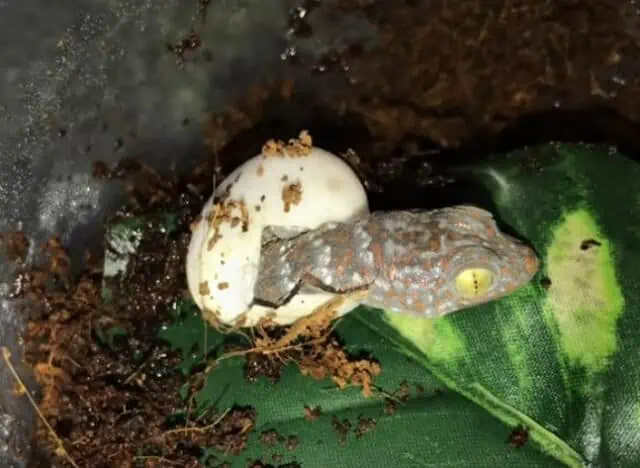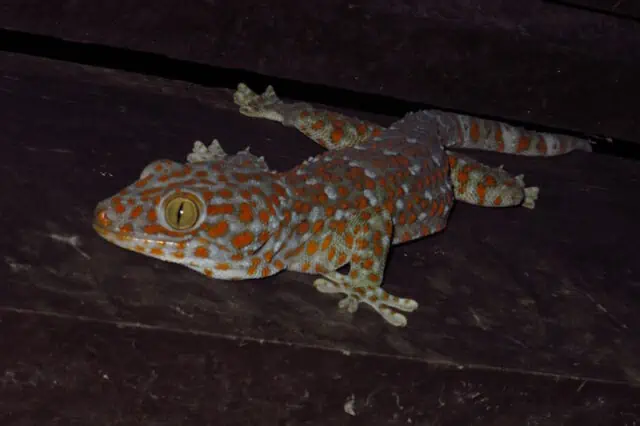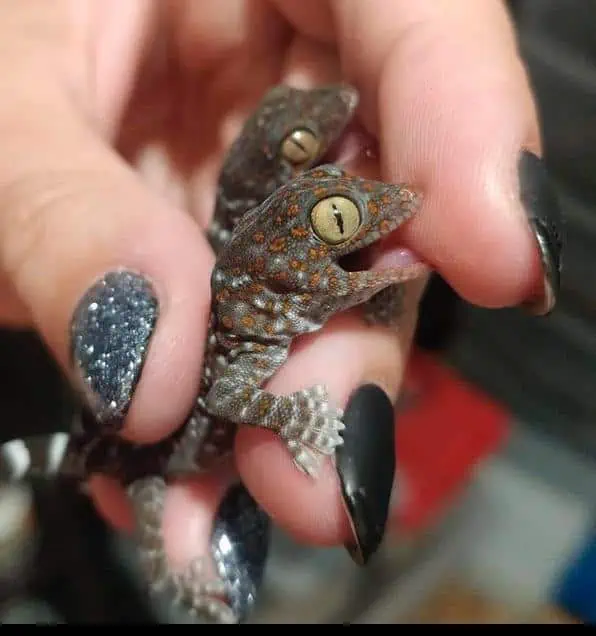It’s fascinating to delve into the life of a creature so exquisitely unique as the Tokay Gecko. These captivating reptiles, with their striking colors and characteristic vocalizations, lead a life that’s as extraordinary as they are. In this article, we’ll navigate the intriguing journey of the Tokay Gecko, right from its birth as a small hatchling, through its teenage and sub-adult years, culminating in its vibrant adult phase.
Along the way, we’ll highlight the changes they undergo, behaviors they exhibit, and the care they need at each stage of life. So, buckle up, because this is going to be an exciting exploration of the lifecycle of one of the most fascinating reptiles on the planet!
Understanding Tokay Geckos: A Brief Overview
Originating from the lush rainforests of Southeast Asia, the Tokay Gecko (Gekko gecko) is one of the most identifiable gecko species due to its vibrant colors and distinct vocalizations. This nocturnal arboreal lizard is known for its bluish-gray body sprinkled with bright orange-red spots, a coloration that provides an excellent camouflage in their native environment. They’re named ‘Tokay’ from their unique call, which sounds like “To-kay, To-kay.”
These geckos are quite large compared to other gecko species, reaching lengths of 12 to 15 inches when fully grown. Their lifespan is relatively long, with some individuals living for 10 to 15 years under suitable conditions, and they display various interesting behaviors and traits throughout their different life stages.
For the prospective or new Tokay Gecko keeper, understanding the life stages of this reptile is crucial for providing appropriate care and ensuring a healthy, happy gecko.
Stage 1: The Hatchling Phase

The journey of a Tokay Gecko begins when it emerges from its egg as a tiny, curious hatchling. Hatchlings are typically about 3 to 4 inches long, just a fraction of their eventual adult size. Their colors at this stage are muted, lacking the bold, bright spots that they’ll develop as they mature. But don’t let their size or subdued appearance fool you, these babies have plenty of character and a natural instinct for exploration.
During the hatchling stage, which lasts for about the first six months of their life, Tokay Geckos are relatively fragile. Their diet primarily consists of small insects, like pinhead crickets and fruit flies, as their small mouths and digestive systems are not yet equipped to handle larger prey. They require a steady supply of calcium and vitamins to support healthy growth and development. Dusting their food with a reptile supplement can ensure they get the nutrients they need.
The hatchlings also need a suitable living environment, one that maintains a high humidity level (around 70%), provides suitable hiding spots, and includes a heat source to keep their little bodies warm. As nocturnal creatures, they prefer environments that mimic their natural habitat in terms of lighting, so it’s advisable to avoid bright, direct light.
Remember, the hatchling phase is when your gecko begins to learn about its world, so gentle handling and a peaceful environment can make this phase of their life less stressful and more enjoyable. It’s also the perfect time for you as a keeper to start building a trust-based relationship with your gecko, leading to a more rewarding experience as it grows.
Despite their vulnerability, hatchling Tokay Geckos are known for their feisty and bold behavior. Their fierce independence may surprise you, but it’s essential for their survival. While handling them, it’s crucial to be patient and gentle as their tiny bodies are still growing and can be injured easily.
Stage 2: The Juvenile Phase
As the hatchling enters the juvenile phase, the gecko starts to come into its own. This phase typically begins around six months of age and lasts until the gecko is about a year old. During this time, the juvenile Tokay Gecko undergoes significant growth and development, almost doubling in size and beginning to display the vibrant coloration and patterns they’re known for.
The juvenile stage is quite an active one as the geckos explore their environment with increased vigor and curiosity. Their climbing skills improve remarkably, and they become more proficient in hunting. Their diet expands to include larger insects, such as crickets and mealworms, and it’s essential to continue the supplementation of vitamins and calcium to support this rapid growth period.
As they grow, their habitat should be adjusted to accommodate their increasing size and activity levels. A larger enclosure, a variety of climbing opportunities, and plenty of hiding spots are essential to make the juvenile gecko feel secure and engaged.
Even as they grow, the Tokay Geckos continue to exhibit their characteristic boldness and, at times, aggression. It’s crucial during this stage to continue the handling routines started in the hatchling stage. Regular, gentle handling can help the gecko get used to human interaction, easing some of their natural defensive behaviors. However, always respect their boundaries and remember that all geckos have unique personalities and comfort levels with handling.
This phase also represents the onset of sexual maturity in Tokay Geckos, although they are not fully grown or ready to breed yet. Subtle changes in behavior can be noticed during this stage, which are indicative of their maturing instincts. Males may start calling, a unique behavior intended to attract a mate and warn off rival males.
Stage 3: The Sub-Adult Phase
The transition from a juvenile to a sub-adult Tokay Gecko is a critical one. This phase typically begins around the gecko’s first birthday and lasts until they’re about 18 months old. It’s a period of continued growth and maturity, where the geckos further develop their distinct adult features and behaviors.
During this phase, the Tokay Geckos reach near their full size, ranging between 8 to 12 inches in length. Their coloration also fully develops, showcasing the stunning bluish-grey body speckled with bright red spots. Male geckos may begin to exhibit more territorial behaviors and vocalizations, which are much louder and more frequent than before.
The dietary needs of sub-adult Tokay Geckos are similar to those of juveniles, but with the inclusion of a wider range of insects and even small mice on occasion. Continued supplementation with calcium and vitamins is important to maintain their health and vigor.
The gecko’s habitat should now mimic that of an adult, with ample space to climb and explore. The provision for basking spots and maintaining appropriate humidity levels is vital for their well-being. As the geckos are nearing their full size, their housing should be large enough to comfortably accommodate them, providing adequate space for climbing, hiding, and hunting.
During the sub-adult phase, the gecko’s relationship with its human caregiver continues to evolve. The reptile’s increased size and strength can make handling a bit more challenging than in the juvenile stage, and their more pronounced territorial behaviors might make them less inclined to tolerate it. It’s important to continue gentle, respectful handling practices, allowing the gecko to guide the interaction.
Despite their increased independence, sub-adult Tokay Geckos still require careful monitoring and care.
Stage 4: The Adult Phase

After about 18 months of growth and development, the Tokay Gecko finally reaches the adult stage of its life. At this point, they are fully grown, typically reaching lengths of 12 to 15 inches, and displaying the full spectrum of their stunning coloration. Their characteristic “To-kay, To-kay” vocalizations, which have been growing in volume and frequency, are now at their most potent. The adult phase is where the Tokay Gecko truly embodies its iconic status in the reptile world.
In the wild, adult Tokay Geckos lead solitary lives, coming together only for breeding. Males, especially, display strong territorial behaviors and may even engage in fights with other males. In captivity, this territoriality necessitates keeping Tokay Geckos singly, unless you’re an experienced keeper facilitating breeding.
The diet of an adult Tokay Gecko is diverse, including a wide range of insects, small rodents, and even other small reptiles. Their larger size allows them to handle bigger prey, providing them with the nutrients they need to maintain their health and vitality. It’s important to continue supplementing their diet with necessary vitamins and calcium, even at this stage.
As adults, these geckos require a large enclosure that mimics their natural habitat, with ample vertical space for climbing and plenty of hideaways. Humidity should still be kept high, around 70%, and they should have a warm basking spot available. While they are hardier than when they were younger, they can still be sensitive to changes in their environment, so it’s important to monitor conditions closely.
Adult Tokay Geckos continue to be as feisty and independent as ever. Regular, gentle handling can continue to reinforce the bond between you and your gecko, but always respect their space and unique personality. Remember, every interaction is an opportunity to deepen your understanding of this fascinating creature.
Special Features and Behaviors Across Different Life Stages
Throughout their life stages, Tokay Geckos exhibit some fascinating features and behaviors that set them apart from many other reptile species. Let’s delve into some of these intriguing characteristics.
One of the most unique traits of Tokay Geckos, regardless of their life stage, is their vocalization. The distinct ‘To-kay’ call, from which they get their name, is commonly heard during the evening or night. It’s louder and more pronounced in mature geckos, especially in males who use it to establish territory and attract mates. Hatchlings and juveniles tend to chirp rather than produce the characteristic ‘To-kay’ sound.
Tokay Geckos are known for their bold, aggressive behavior, which is present even in hatchlings. They aren’t shy about defending themselves, and they will bite if they feel threatened. This behavior is more prominent in adults, especially males, who can be quite territorial.
In terms of physical features, the vibrant coloration of Tokay Geckos is one of their defining characteristics. However, this trait isn’t fully developed at birth. Hatchlings have a more subdued coloration that gradually develops into the stunning blue-gray and orange-red pattern as they mature.
One of the more unusual behaviors exhibited by Tokay Geckos is their ability to shed and regenerate their tail. This defense mechanism, known as autotomy, is most commonly seen in juveniles and sub-adults. When threatened, they can drop their tail to distract a predator, providing them with a chance to escape. Over time, they regenerate a new tail.
Health Concerns and Care Requirements at Each Stage
As your Tokay Gecko transitions through its different life stages, it’s important to be mindful of various health concerns and care requirements. Doing so ensures your gecko stays healthy and happy throughout its life.
In the hatchling and juvenile stages, a common health concern is Metabolic Bone Disease (MBD), caused by inadequate calcium in their diet. Symptoms include deformities, weak limbs, and lethargy. To prevent this, ensure a calcium-rich diet and appropriate UVB lighting.
Another common issue across all life stages is parasitic infection, which can occur from contaminated food or living conditions. Regular fecal examinations can help detect and treat these issues early.
In the sub-adult and adult stages, obesity can become a problem if the geckos are overfed or their diet isn’t properly balanced. Monitor their weight and diet closely, ensuring they get the right quantity and variety of food.
Throughout their life, Tokay Geckos are also prone to respiratory infections, often caused by incorrect humidity levels. Maintaining appropriate humidity in their enclosure is key to preventing such issues.
When it comes to care requirements, providing a suitable environment that mimics their natural habitat is paramount. This includes a spacious enclosure with climbing and hiding spots, appropriate temperature and humidity levels, and proper lighting. Their diet should be varied and supplemented with necessary vitamins and minerals.
Conclusion
From the moment they hatch to their majestic adulthood, Tokay Geckos exhibit an array of fascinating behaviors and physical transformations that truly set them apart in the reptile world. Each life stage brings its own charm, challenges, and rewards. As a keeper, understanding these stages is crucial in providing optimal care for your gecko, ensuring not just their physical well-being, but also fostering a meaningful bond with them.
Remember, the journey of a Tokay Gecko from a small hatchling to a robust adult is a unique spectacle. Each stage presents opportunities to understand, appreciate, and connect with these fascinating creatures on a deeper level. Whether you’re a seasoned herpetologist or a first-time gecko owner, there’s always something to learn, admire, and enjoy in the life of a Tokay Gecko.
FAQs
When do Tokay Geckos reach full size?
Tokay Geckos reach their full size around the 18 months mark, when they transition from the sub-adult stage to the adult stage. They typically grow to be 12 to 15 inches long.
What do Tokay Geckos eat at different stages of their life?
Hatchlings and juveniles mainly eat small insects like pinhead crickets and fruit flies. As they grow and enter the sub-adult and adult stages, they can consume larger insects, small rodents, and even other small reptiles.
How long do Tokay Geckos live?
With proper care, Tokay Geckos can live up to 10 to 15 years in captivity.
What should I do if my Tokay Gecko isn’t growing?
If you notice that your Tokay Gecko isn’t growing as expected, it could be due to inadequate nutrition or a health issue. It’s recommended to consult a veterinarian who specializes in reptiles.
How do I know if my Tokay Gecko is healthy?
Signs of a healthy Tokay Gecko include clear eyes, smooth skin, regular eating, and active behavior. If you notice anything unusual such as lethargy, loss of appetite, or visible deformities, it’s best to consult a veterinarian.
Can Tokay Geckos cohabitate?
Adult Tokay Geckos are typically solitary and territorial creatures. They can become aggressive with each other, so it’s generally advised to house them separately unless you’re an experienced keeper facilitating breeding.
Why is my Tokay Gecko losing its color?
Tokay Geckos can change color due to various factors including stress, illness, or natural shedding. If the color change is accompanied by other symptoms or abnormal behavior, it’s best to seek veterinary advice.
How often should I handle my Tokay Gecko?
The amount of handling a Tokay Gecko tolerates varies by individual and life stage. Start with brief, gentle handling sessions and adjust based on your gecko’s reactions. Always handle your gecko with care to avoid causing stress or injury.
What’s the best way to care for a Tokay Gecko hatchling?
Tokay Gecko hatchlings require a warm, humid environment, small insect prey, and gentle handling. Ensure their enclosure mimics their natural habitat and supplement their diet with necessary vitamins and calcium.
How can I identify the sex of my Tokay Gecko?
Sexing Tokay Geckos can be challenging in the early stages, but once they reach sexual maturity, males typically have broader heads and larger bodies than females. Males also have preanal pores and hemipenal bulges that females do not. Consulting with a reptile expert or veterinarian can help confirm the sex of your gecko.





